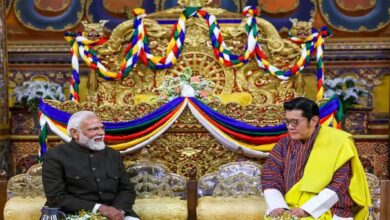A benchmark for RJD’s social media presence
The first “field test” for RJD’s persistent efforts to broaden its base of support outside the traditional Muslim-Yadav (MY) voter base will come on April 19, when the first phase of the Lok Sabha election is slated to take place in four seats.

In the first phase of the election, the RJD fielded two Kushwahas: Abhay Kushwaha from Aurangabad and Shravan Kushwaha from Nawada. They are up against two higher caste candidates from the BJP, Sushil Kumar Singh and Vivek Thakur.
Jamui and Gaya will also cast ballots in the first round of the Lok Sabha election, in addition to Aurangabad and Nawada. It’s noteworthy that the Maoist threat mostly affects all four constituencies.
Former Bihar chief minister Jitan Ram Manjhi, a supporter of the Hindustani Awam Morcha (HAM), and RJD candidate Kumar Sarvjeet, a former minister, are running in the Gaya Lok Sabha seat. The seat was formerly held by JD(U) member Vijay Kumar, also known as Vijay Manjhi, in parliament.
Political parties mostly concentrate on the votes of EBCs, OBCs, and Upper castes, despite the fact that the Gaya seat has been reserved for scheduled caste for the previous 25 years. More than 2.5 lakh voters identified as Manjhi, or Mushahar. There are also a significant number of Pasi (who sell toddy), Dhobis (washermen), and Dusadh (Paswan) members.
However, the brother-in-law of the party president and MP Chirag Paswan, Arun Bharti, the LJP (Ram Vilas candidate), will face RJD candidate Archana Ravidas in a straight-up battle. Chirag, who was elected twice from this seat (in 2014 and 2019), has given his relative the seat.
Prime Minister Narendra Modi will go to Jamui on April 4 and Nawada on April 7 ahead of the elections. In the 2019 election, PM Modi also began his campaign from Jamui. This demonstrates Modi’s tight ties to the senior Paswans’ family.
Rajput caste member Sushil Singh, the MP for Aurangabad, has won elections in 2009, 2014, and 2019 to represent the seat three times in a row. He is seen to have an advantage over the RJD contender. Even if Singh has to contend with anti-incumbency sentiment as well, Modi’s rallies are probably going to offset it.
The RJD nominee is expected to encounter opposition from Congressmen, particularly those who back former MP Nikhil Kumar. Prior to the formal announcement of the seat-sharing agreement, Kumar’s supporters had displayed a banner of rebellion against the party emblem assigned to the RJD candidate.
RJD, however, is attempting to gain ground on EBC-OBC voters by offering Kushwaha a ticket rather than any Rajput from the upper caste. Bihar’s Aurangabad is referred to as “Chittaurgarh” since there are a significant number of Rajputs living there.
It might be “suicidal” for RJD to deny a ticket to Nikhil Kumar, the son of former Bihar Chief Minister Satyendra Narayan Sinha. Congress has always had its headquarters in Aurangabad. In the recent past, RJD fielded a candidate for the first time.
Similar to Singh, Vivek Thakur, the BJP candidate from Nawada, is initially preferred over RJD candidate Shravan Kushwaha since a significant portion of the Bhumihar community resides in the area. Thakur is an upper caste member. The BJP contender is the son of renowned physician Dr. C P Thakur, a former federal health minister.
Former LJP member Chandan Kumar Singh held the position. Surajbhan Singh, a former don who is now a politician, is the brother of Chandan, a Bhumihar by caste. The BJP has fielded Vivek Thakur in the 2024 Lok Sabha elections. Giriraj Singh (BJP) had taken the seat in 2014.
Chirag’s brother-in-law Bharti is a newcomer to the Jamui seat, but he is predicted to win handily because of the leader of the LJP (Ram Vilas). Chirag won elections in 2014 and 2019 to represent the Jamui Lok Sabha seat twice.
Sarvjeet and Manjhi are expected to engage in a fierce race for the Gaya Lok Sabha seat. Manjhi lost the JD (U) candidate in the most recent Lok Sabha election by a margin of more than 1.52 lakh votes. In the last election, Manjhi’s HAM was a member of the grand alliance.
The Aurangabad Historically referred to as “Chittorgarh of Bihar,” Rajput candidates have held the seat since 1955. To date, no non-Rajput has emerged victorious from this seat in an election. Greeting guests to the town is a large statue of Maharana Pratap perched on his horse, “Chetak.” About 12.5% of the electorate is Rajput, 11.2% is Muslim, 9.6% is EBC, 15.5% is Yadav, and 6.5% is Kushwaha (OBC). Who wins the seat can be decided by Muslims and Rajputs.
Gaya’s religious importance stems from its foundation on the Falgu River. This is the site of the globally renowned Mahabodhi Mahavihara (Temple), where Gautam Buddha attained enlightenment. For the last twenty-five years or more, candidates from the Manjhi—Musahar Scheduled Caste have been running for the seat. Muslims make up 10.58% of the population, but in the reserved constituency, SCs get 17.15% of the votes. Additionally, the number of STs is just 3.27%. Voters belonging to the Scheduled Caste group are crucial to the candidates’ success.
Nawada
Since the Bhumihars are crucial to the candidate’s win, contenders from higher castes are running for the seat. SCs get 24.66% of the vote, compared to 10.17% of Muslims. The population of SCs in the constituency is under 0.01%.
Jamui Jamui, which was once known as Jambhyagram, has a rich history that extends back to the time of the Mahabharata. Its religious significance is increased by its affiliation with Jainism, especially since it is said to be the site where Lord Mahavir received heavenly wisdom. SCs make up 17.09% of the population, while Muslims make up 10%. Only 3.45% of STs reside in the seat.







